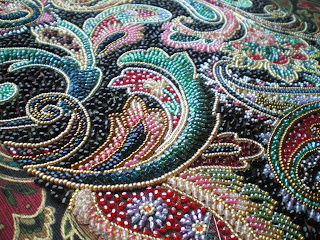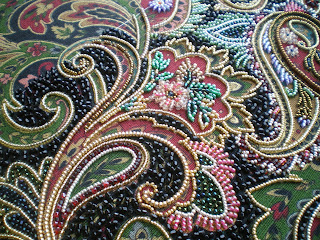© JEC/Carol-Anne Conway
When I started Japanese Bead Embroidery in 2008 I only wanted to learn this beautiful art form and as I worked my way through the phases my love of beads and bead embroidery grew. In 2010 I learned that my tutor, the only one in the UK, was immigrating to New Zealand and shortly after that the 2011 beading classes at the JEC were cancelled because Matsukawa-sensei had fallen ill. There was some doubt if she would ever return to Atlanta to teach another beading class. I was devastated to think that my journey into JEB was coming to an end when it had barely begun. I was also deeply saddened to think that there would nobody in the UK qualified to share JEB with others. I resolved to progress as far as possible before my tutor left for New Zealand.
In June 2011 it was announced that Matsukawa-sensei would return to Atlanta in 2012. I was elated, now I might be able to complete my journey and even began to foster thoughts that someday I might qualify to teach JEB in the UK. I determined to be in that class. Sadly, ill-health once again prevented Matsukawa-sensei from travelling but fortunately this time a substitute teacher was found and the class went ahead.
© JEC/Carol-Anne Conway
Phases I-IV are designed to teach the various techniques of bead embroidery. At Phase V the student is required to come up with their own stitching plan that demonstrates all they have previously learned. It is hard: there are no instructions and no pictures to refer to, only your own imagination. Umematsu-san is there to offer advice and guidance but the class is only 3 days long. After that you take your piece home and you are on your own.
I thoroughly enjoyed beading my Pouchette but all the time I was wondering how well I was doing. Do my colour selections work? Do the stitches I have used enhance the fabric design? In class, Umematus-san had mentioned that my lines of gold beads could be smoother. I tried hard to make them so but was I succeeding? I was elated when I finished the beading and felt that I had done my best work but would it be good enough to be approved by Matsukawa-sensei and Uematsu-san?
© JEC/Carol-Anne Conway
At the beginning of March I finally received the news that I had been waiting for. Matsukawa-sensei approved my work and I am qualified to teach Japanese Bead Embroidery. My certificate arrived in the post a few days ago.
So that is it the end of my Journey! Except that it is not the end, it is the beginning of a new phase. My good friend and fellow beading enthusiast, Sue, who travelled to Atlanta with me in 2012 has also qualified and together we plan to start teaching Japanese Embroidery here in the UK. A new journey begins!
© JEC/Carol-Anne Conway
Happy Stitching




































